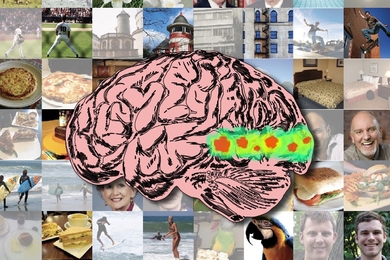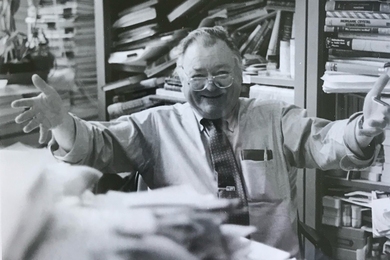For decades the human Y chromosome, the male sex chromosome, has been the Rodney Dangerfield of human genetics--"it don't get no respect."
"As recently as 10 years ago, many textbooks claimed that the Y chromosome carried only a single gene, the sex-determining gene," said Dr. David Page, associate professor of biology and associate director of the Whitehead/MIT Center for Genome Research. "Even when we did find other genes on the Y, they generally turned out to be copies of genes found on the X chromosome," the sex chromosome present in both females and males. Dr. Page is also an assistant investigator with the Howard Hughes Medical Institute.
In evolutionary terms, the Y chromosome appeared to be little more than a smaller, less stable version of the X. It even had a habit of losing genes--in part because evolutionary pressures made the complementary genes on the X chromosome more robust. Some early discussions about mapping the human genome ignored the Y chromosome altogether.
Now, new evidence from Dr. Page and his collaborators at Whitehead, MIT and the University of Washington reveals that the Y chromosome has led an independent existence after all. Their studies of a gene called DAZ, which appears to be involved in sperm production, challenges the conventional wisdom about sex-chromosome evolution and supports theories that the Y chromosome may provide a safe haven specifically for genes that enhance male fertility.
"For the first time, we're focusing on what the Y chromosome does, rather than what it doesn't do," said Richa Saxena, a graduate student in Dr. Page's laboratory and the first author of a report describing these results in the November 1 issue of Nature Genetics. "We can ask how evolution has taken advantage of an entire chromosome that occurs exclusively in one sex."
The answers will increase understanding of male fertility and could lead to new diagnostic techniques for thousands of infertile men.
All human embryos inherit 23 pairs of chromosomes: one pair of sex chromosomes and 22 pairs of non-sex, or autosomal, chromosomes. Embryos that inherit two X chromosomes (one from each parent) develop into females. Embryos that inherit an X chromosome from their mother and a Y chromosome from their father develop into males.
The conventional wisdom has been that the mammalian X and Y chromosomes evolved together from two autosomal chromosomes about 120 million years ago, and that any additions to the Y chromosome since that time have depended entirely on interactions with the X chromosome. However, tools emerging from the Human Genome Project have made it possible to reexamine these theories using detailed information about the structure and function of individual elements of the human genome.
DISCOVERY OF DAZ AND DAZH
Four years ago, Dr. Page and his associates created the first comprehensive physical map of the Y chromosome, greatly enhancing the search for Y-chromosome genes. Then last year, they identified a gene that is present in fertile males but completely absent in some otherwise healthy men who were completely devoid of sperm production (a condition called azoospermia), as well as some men with extremely low sperm counts (severe oligo-spermia). This Y chromosome gene, called DAZ, for "deleted in azoo-spermia," has a number of interesting properties: it occurs in multiple copies on the human Y chromosome, it is switched on exclusively in germ cells (cells that give rise to sperm) in the human male testes, and according to the latest report in Nature Genetics, it has a homolog (an almost identical match in genetic terms) on human chromosome 3, an autosomal chromosome. This newly discovered homolog of DAZ is called DAZH.
"The discovery of DAZH has allowed us to explore the origins of DAZ-and the evolutionary history of the Y chromosome itself-in a way never before possible," Dr. Page said.
Through careful analysis of the protein products of the two human genes, as well as closely related genes in the fly and the mouse, Dr. Page and his collaborators determined that an ancestral DAZH gene gave rise to the Y-chromosomal DAZ gene sometime during human evolution, after the separation of primate and mouse lineages. This evidence represents the first time that a Y chromosome in any species has been shown to acquire a fertility factor during evolution, independent of the X chromosome.
"The autosome-to-Y transposition of male fertility factors may be a recurrent theme in Y chromosome evolution," Dr. Page said. "In future studies, we'll be searching for other genes on the Y chromosome that have autosomal ancestors and exploring how the autosome-to-Y transposition might have provided a competitive advantage for males early in the development of the human species."
This work was supported in part by the National Institutes of Health, the Howard Hughes Medical Institute and the March of Dimes Birth Defects Foundation. Other authors of the Nature Genetics paper include Dr. Helen Skaletsky, Dr. Renee Reijo, Laura G. Brown and Raaji K. Alagappan from the Page laboratory; Dr. Trevor Hawkins and Dr. Steve Rozen from the Whitehead/MIT Center for Genome Research; and Drs. Mary Beth Dinulos and Christine M. Disteche from the Department of Pathology at University of Washington in Seattle.
A version of this article appeared in MIT Tech Talk on November 6, 1996.





